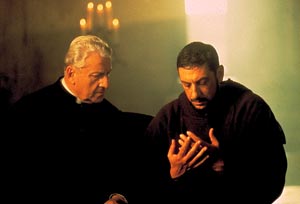ABOUT THE FILM
 Padre Pio—Miracle Man sets out to portray the life, times and personality of St. Pio of Pietrelcina. It couldn’t have been an easy task for the writers and producers. An encyclopedic amount of information about Pio is available, a veritable ocean of facts, legends, and rumors. They had to decide what to include and what to leave out in order to fit a specific movie length, managing at once to sustain viewer interest and be true to the spirit of the saint. A dramatic film biography—as opposed to a documentary—is not a strict narration of facts. Artistic license comes into play in Padre Pio, just as it does in films such as The Ten Commandments or Jesus of Nazareth. Supporting characters might be composites of several historical persons, or they may be entirely fictional, conceived to symbolize a larger truth or simply to hold the story together. (a good example is the "Inquisitor" priest who appears throughout this film.) The chronology of events may be changed around, and "boring parts" eliminated in order to keep the action going. As a result, historical outcomes that evolved over a period of years can seem to occur within a few weeks in a movie. If in places the historical record is sparse (e.g. the subject’s childhood) the film makers may speculate and "fill in" with episodes or dialogues that are not at all certain to have taken place. But good film makers will make sure their speculations are in harmony with what is known about the subject. For example, some of the dialogue spoken by little Francesco was taken from things he actually did say years later. >> NEXT PAGE Padre Pio—Miracle Man sets out to portray the life, times and personality of St. Pio of Pietrelcina. It couldn’t have been an easy task for the writers and producers. An encyclopedic amount of information about Pio is available, a veritable ocean of facts, legends, and rumors. They had to decide what to include and what to leave out in order to fit a specific movie length, managing at once to sustain viewer interest and be true to the spirit of the saint. A dramatic film biography—as opposed to a documentary—is not a strict narration of facts. Artistic license comes into play in Padre Pio, just as it does in films such as The Ten Commandments or Jesus of Nazareth. Supporting characters might be composites of several historical persons, or they may be entirely fictional, conceived to symbolize a larger truth or simply to hold the story together. (a good example is the "Inquisitor" priest who appears throughout this film.) The chronology of events may be changed around, and "boring parts" eliminated in order to keep the action going. As a result, historical outcomes that evolved over a period of years can seem to occur within a few weeks in a movie. If in places the historical record is sparse (e.g. the subject’s childhood) the film makers may speculate and "fill in" with episodes or dialogues that are not at all certain to have taken place. But good film makers will make sure their speculations are in harmony with what is known about the subject. For example, some of the dialogue spoken by little Francesco was taken from things he actually did say years later. >> NEXT PAGE
|



